Window tinting on the balcony: types of films, selection criteria and installation features
In hot weather, going out onto the balcony located on the sunny side of the house is another challenge, don’t you agree? And, if on the first floors the trees growing nearby save the situation a little, then for residents of the upper floors the air on the balcony warms up to such an extent that it becomes uncomfortable to be there. The situation can only be saved by tinting the windows on the balcony, which will help protect the room from the scorching rays of the sun.
In this material we will talk about what films are used for window tinting, how to choose the appropriate option, and also how to install the film on your balcony windows yourself.
The content of the article:
What is window tinting?
Windows are an integral part of every home. It is through them that sunlight penetrates into our houses and apartments. But sometimes there is a lot of this sunlight, which causes the air to warm up too much.
In addition, under the influence of direct sunlight, furniture and appliances deteriorate, wallpaper fades, etc. In order to avoid all these troubles, use window tinting on balconies and loggias.
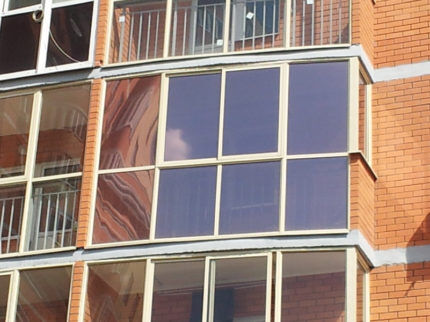
Window tinting involves covering the glass with special films. At your discretion, you can choose the degree of darkening, preferring a darker/lighter option.
This service is quite expensive, but you can do the tinting on your own without resorting to the services of specialists. To do this, you will need to choose the appropriate material and do the pasting yourself, but more on that below. First, let's look at the types of tint films.
Types of tint films
Having finally decided on the need to tint the windows, not everyone thinks about how important it is to purchase high-quality material. As a rule, they buy the first film they come across, but this is highly undesirable.
First, you need to understand what protective films are, and then finally decide on the choice of the appropriate material.
Option #1 - sun protection
Sun protection or darkening film is one of the most popular materials for tinting balconies and loggias. It is capable of blocking about 98% of ultraviolet radiation.
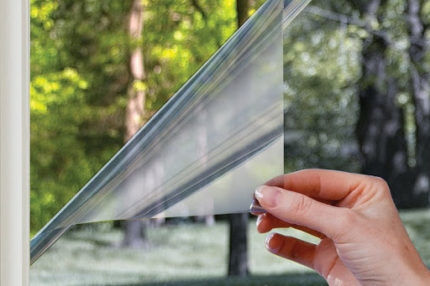
In addition to its main function - to protect the room from sunlight, this film allows you to maintain a comfortable temperature on the balcony all year round.
Option #2 - mirror
This version of the film is used to create visibility from only one side of the glass, most often the inside.
At the same time, from the street side, the effect of a mirror surface is created, thanks to which no one will see the decor of your loggia, clothes dryer or a mess on the balcony.
Mirror film reflects up to 95% of sunlight and 75% of heat, thereby creating a comfortable atmosphere indoors.
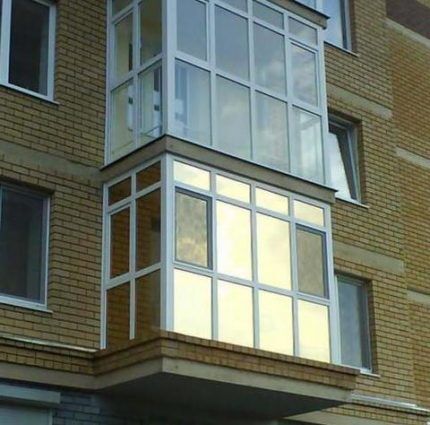
Option #3 - shockproof
Shockproof or protective film is most often used to protect double-glazed windows by residents of lower floors. It protects the glass from chips and cracks, for example, if a small stone is thrown at it.
In addition, the shockproof film has fire-fighting properties and protects the balcony premises from direct sunlight.
Option #4 - decorative
This film option is perhaps the most diverse of all those listed. There are many colors, patterns and designs available for sale.
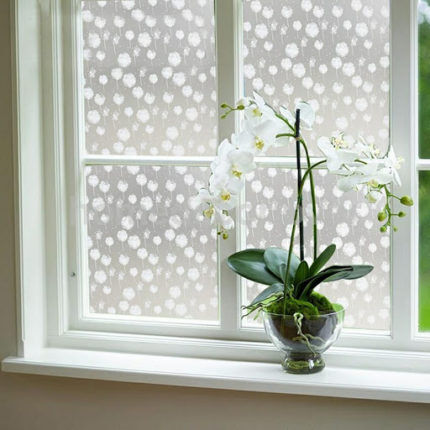
If desired, you can choose an option that will fit perfectly into any room design and, in addition to practical benefits, will perfectly complement the interior.
Features of film selection
In order not to be disappointed with the result obtained, when choosing a tint film, be sure to pay attention to such an indicator as light transmission. It is expressed as a percentage and the higher this value, the higher the ability of the material to transmit light.
The next thing to pay attention to is film color. Of course, choosing the color of the film that suits the interior of the room is not so difficult, but do not forget that the color is directly related to the ability of the material to transmit sunlight.
| Film color | Transparency level, % |
| Silver | 15-50 |
| Violet | 15 |
| Gold | 15-35 |
| Bronze | 15 |
| Smoky | 20 |
| Green | 15 |
| Grey | 15-35 |
| Blue | 15-35 |
| Solar Bronze | 20-35 |
Brand and price. You should also not save on material by purchasing cheap and low-quality products. It will be money wasted.Such material will not provide sufficient protection from sunlight, and is unlikely to last long.
Therefore, it is better to give preference to well-established manufacturers. Among which are: Armolan, Professional Window Film, Sun Control, Ultra Vision, Eastman Chemical.

It is also important protective layer against scratches. Most cheap materials simply do not have it, so leaving a mark on such a coating will not be difficult, which cannot be said about branded films that have reliable protection against mechanical damage.
If you live on the ground floor, it would be a good idea to purchase a protective film of class A1 - A3. With such a coating, double-glazed windows will be almost impossible to break.
Instructions for self-tinting
To save a little on window tinting, you can do the work yourself. There is nothing complicated about this, and the tools that are needed for the job can probably be found in every home.
So, for work you will need to prepare:
- tint film;
- window cleaner;
- spray;
- microfiber cloth;
- stationery knife;
- plastic or rubber spatula (the second option would be preferable).
Having prepared everything you need, you can start gluing the glass on the balcony.

Before covering windows, it is very important to thoroughly clean the glass. To clean the canvas from dirt and dust, you can use robot vacuum cleaner for windows. Then use window cleaner, alcohol or a special product to degrease the surface.
Make sure that there is not the slightest trace of dirt left on the glass. After all, even the slightest lint or speck of dust, once under the film, can cause bubbles or peeling.
At the next stage, you need to measure the visible part of the glass and cut out a piece of glass of the required size from the film. This can be done in advance; even before cleaning the glass, prepare blanks of the required size. This will save you some time.
Next, you need to spray the surface of the glass with water from a spray bottle, remove part of the film from the protective layer and carefully apply it to one of the upper corners of the glass.
Carefully glue the film to the glass using a spatula or towel. Bubbles may appear during work; they will need to be smoothed out immediately with a spatula. Try to carefully smooth out every millimeter of the film - its service life will depend on this.
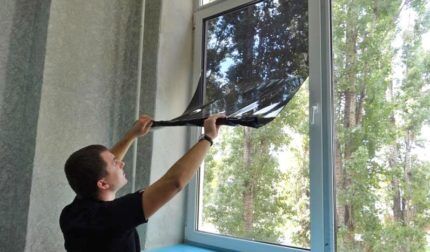
When all the film is pasted, check if there are any protruding edges beyond the edge of the glass. If there are any, they can be carefully trimmed using a stationery knife.
When gluing glass, you need to monitor the humidity level in the room where the work is being carried out.Too dry/humid air can cause poor adhesion of the film to the glass, which will consequently negatively affect its service life.
Advantages and disadvantages of tinted windows
The main benefit of window tinting is dimming sunlight. This is especially true when the balcony or loggia is on the south side and bright sunlight does not allow you to comfortably stay indoors.
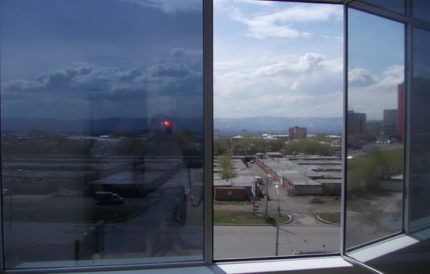
Unlike curtains, films do not accumulate dust in incredible quantities, so they do not require such careful care. To maintain cleanliness in the room, it will be enough to only occasionally wipe the windows from dust.
Another undeniable advantage of films is their durability. By tinting the windows on your balcony, you will get rid of bright sunlight penetrating into the room for a long time.
In addition to protection from bright light, the material also protects a person from the harmful effects of ultraviolet radiation, which is also important.
With the help of decorative film you can decorate any room and give it a unique “zest”.
It is also worth mentioning the fact that the tint film does not heat up from the sun's rays, but reflects them. This will help reduce the room temperature by several degrees, which is especially important on hot sunny days.
The last-mentioned advantage of tinting can also be considered its disadvantage, because in the winter season the air in the room will warm up much more slowly than in rooms with untinted windows.
Also, you should not tint windows that are located on the north side, since sunlight practically does not penetrate into such rooms.
Conclusions and useful video on the topic
A specialist talks about how to do window tinting yourself:
How to tint windows with the removal of double-glazed windows will be discussed in the following video:
As you can see, there is nothing difficult about tinting windows on the balcony. The main thing is to have a little free time, patience, a minimal set of tools and strictly follow the instructions. And choosing the right material will not be difficult, since the range on the market is quite extensive.
Have you ever had to apply window tint film yourself? Please tell our readers if there were any difficulties during the work and how you dealt with them. Or are you just about to start tinting and still have questions? You can ask our experts - the feedback block is located under the article.



